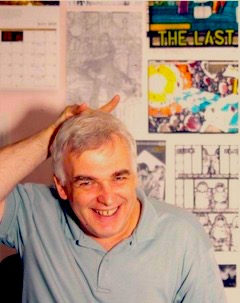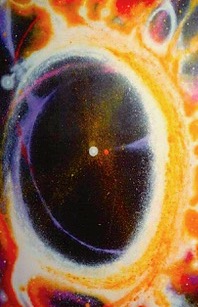Kirk to Harry Mudd - second season episode “I, Mudd.”
by Helmut Eppich
FOREWORD

Watching classic science fiction movies, such as “Conquest Of Space” and “Forbidden Planet” (which inspired Star Trek) on Sunday afternoons prompted my childhood interests in science fiction. Then I found Star Trek, science fiction novels, science fiction pulp anthology magazines, comic books, and graphic novels. From there I discovered a golden-age and contemporary celebrated science fiction-fantasy illustrators in that genre as well as various types of comic book scripts. That led to purchasing published screenplays and teleplays from which science fiction film and television series set designers brought their visions to life.
I also illustrated stories on a freelance basis for independent comic book publishers: Pacific Comics, Blackthorne Publishing, Inc., Harris Comics, and “Cosmic Waves”, a science fiction anthology comic magazine. Currently, I'm working on a new Demon Boy Comic book, the first in a second volume of three. The first three are currently in development as an omnibus issue.

My space paintings around the college were a natural evolution from illustrating science fiction comics. They were inspired by a combination of astronomical images taken with The Hubble Telescope, Hayden Planetarium Light Shows, and traditional PBS astronomy television mini-series such as “COSMOS”, hosted by the late, preeminent astronomer, Carl Sagan. Highly acclaimed astronomical illustrators created various types of space art for the mini-series. Noting those illustrators' names in the show's end titles, I looked up their work, which became inspirations for future space paintings.
Those space paintings served as the basis for a solo exhibition in Soho at 55 Mercer Gallery with a series of 3'x4' canvas paintings. I received the greatest compliment an artist could ever obtain. The gallery sitter always stopped to admire my exhibition by himself when leaving for the night. He had never done that with any other exhibition...
Live Long and Prosper.

Second pilot - “Where No Man Has Gone Before”.
LEFT - ENTERPRISE penetrates energy barrier at the edge of our galaxy (remastered special effects),
RIGHT - Spock listens to incoming signals from an old Earthship probe
“It was a hell of a first year.” – Gene Roddenberry, Star Trek's creator.
“We almost lost our minds.” - Deforest Kelley, Doctor Leonard McCoy.
Both men weren't kidding. Gene Roddenberry and his executive producer, Bob Justman, nearly had nervous breakdowns. The production crew, director, and actors worked twelve to fourteen hours a day on the set. Their schedule was grueling. Star Trek had gotten its green light as a series, winding up on NBC's 1966 Fall Schedule. Pressure was on. Years later everyone who worked on the set agreed it was the hardest job they ever had but enjoyed every second of it. They knew something special was happening.
After two pilots, sets had to be upgraded, uniforms redesigned, phasers, communicators rebuilt. Tricorders invented and constructed from scratch. Scripts and writers were commissioned and hired according to a grueling schedule. A cheap budget served to increase creativity. Trek's Set decorator, John Dwyer, had trouble satisfying Gene Roddenberry's demands for exotic plants. Gene's frustration grew every time John Dwyer, returned with an unsatisfactory alien plant. Finally, out of desperation, Gene removed the lant, and shoved it back upside down into its pot, roots dangling up in the air.

LEFT - Briefing room - First Pilot - “The Cage” (also known as “the menagerie”),
RIGHT - Briefing Room - Second Pilot - “Where No Man Has Gone Before”.
Also, standing sets were redressed as different sections of the ENTERPRISE. Transporter Room was redressed as the ship's chapel. Kirk's quarters were redressed as Spock's, McCoy's, Scotty's, Uhura's, and passenger quarters. The ship's briefing room was redressed as the ship's recreation room as well as the interior of an alien ship (balok's ship, phesarius, from "the corbomite maneuver"). The ship's gymnasium was a conglomeration of the engineering set.
During the first half of Star Trek's initial season, Gene Roddenberry continually rewrote scripts, sometimes on location during filming. Esteemed science fiction writers such as Theodore Sturgeon, Norman Spinrad, George Clayton Johnson, Richard Matheson, Harlan Ellison, Paul Schnieder, Stephen Kandel, Robert Bloch, Frederick Brown, Jerome Bixby, John Meredith Lucas, submitted plots and story outlines, to be, hopefully, commissioned as full teleplays. During the first year Gene Roddenberry eventually complained that struggling to write new scripts was like working with science fiction writers who did not understand writing for television and television writers who did not understand writing science fiction.

LEFT - Transporter Room - First Pilot - “The Cage“,
RIGHT - Transporter Room - Original Series.
Every Star Trek script required rewriting. Gene Roddenberry's motto was “Scripts aren't written. They're rewritten.” At the beginning no writer really understood Star Trek except for Gene Roddenberry himself. Case in point: There were no regular manual hatches and doors aboard the ENTERPRISE. All hatches and doors operated automatically. Small details such as those along with characterizations and odd storylines had to be corrected in various rewrites.
The Trek cast were trying to find and create their characters during that first, strenuous year as implied by Roddenberry's rewritten scripts. Roddenberry's and the cast's talents along with their imagination in conjunction with episode directors and production crew brought Trek's characters and stories to life. Gene Roddenberry had written a show's bible. It contained descriptions of the sets, characters, and ship's mission laid down in print for actors, writers, and directors to follow when putting together episodes.
Actors, writers, directors, production crew were also struggling to find ways of working against their grueling schedule, enabling stories to come alive through characterization, special effects, music, lighting, sound effects, alien makeup, drama, and action adventure.

LEFT - Bridge - First Pilot - “The Cage”,
RIGHT - Bridge - Second Pilot - “Where No Man Has Gone Before”.
Star Trek was always behind schedule. Rewrites and retakes of individual scenes along with delayed waiting times for availability of special effects had to be incorporated into episodes, so that they could be completed and delivered on time to the network for scheduled airing.
Unfortunately, Gene Roddenberry's continual rewriting of these esteemed famous science fiction writers' scripts became annoying to them. They weren't accustomed to having their stories rewritten. Would Roddenberry's rewrites either enhance or detract from their scripts? Star Trek's initial story editor, John D. F. Black, witnessed Gene Roddenberry alter scripts written by these treasured science fiction writers. John D. F. Black had written and turned in a first season script himself. It became one of the first season's best episodes, (“the naked time”) not expecting to be rewritten because of his close familiarity with Star Trek.
Coming in on a Monday, he found out that Gene Roddenberry also rewrote HIS script over the weekend! John D. F. Black complained vehemently against rewrites. John D.F. Black decided it was time for him and his wife to leave. The parting, however, was on completely amicable terms.

LEFT - Starship ENTERPRISE - First Pilot - “The Cage”,
RIGHT - Starship ENTERPRISE - Original Series.
Roddenberry would often procrastinate, typing out scripts at the last minute. Occasionally, Bob Justman came up to Roddenberry's office from the set during filming and tried to get Gene's attention for a script change so that filming could resume. Gene ignored him, continuing to type. Finally, exasperated, Bob Justman got up onto Roddenberry's desk and stood there until Roddenberry made the required script changes.
Network censors didn't help things either. The open-mouthed kiss was one of the network's biggest complaints. Being careful not to alarm the viewer with graphic sex and violence was another network censor credo. Revealing bellybuttons was another major concern. How times have certainly changed!
Roddenberry, as with Bob Justman, succumbed to the grueling schedule physically and emotionally. Gene L. Coon, having written excellent scripts for other shows, was brought in midway through the first season to relieve writing pressures from Gene Roddenberry. Gene L. Coon was made associate producer. Klingons, humor, Starfleet Command, The Federation, and General Order Number One, (prevented a starship captain from interfering with normal developments of civilizations and cultures), were his contributions to Star Trek.

LEFT - Spock, Sulu - Second Pilot - “Where No Man as Gone Before”,
RIGHT - Spock, Sulu - Original Series.
Gene Roddenberry's Star Trek was expanding. Gene L. Coon was the first of many others to add further details, suggestions, and recommendations.
Gene Roddenberry stated that writing Star Trek required following a certain, consistent format. Star Trek was a show that operated within its own universe of phasers, photon torpedoes, communicators, tricorders, warp drive, transporters, shuttlecraft, Starfleet Command, General Order Number One, The Federation, Starbases, Klingons, Romulans, Vulcans, Gorns, Tellarites, Organians, tribbles, Metrons, Thasians, time travel.
In the second season more characters, stories, and cultures would evolve, loosening and lightening up due to Gene L. Coon's adventurous, humorous writing style. Gene Roddenberry did not approve.

LEFT - Beaming Effect - First Pilot - “The Cage”,
RIGHT - Beaming Effect - Second Pilot - “Where No Man Has Gone Before”.